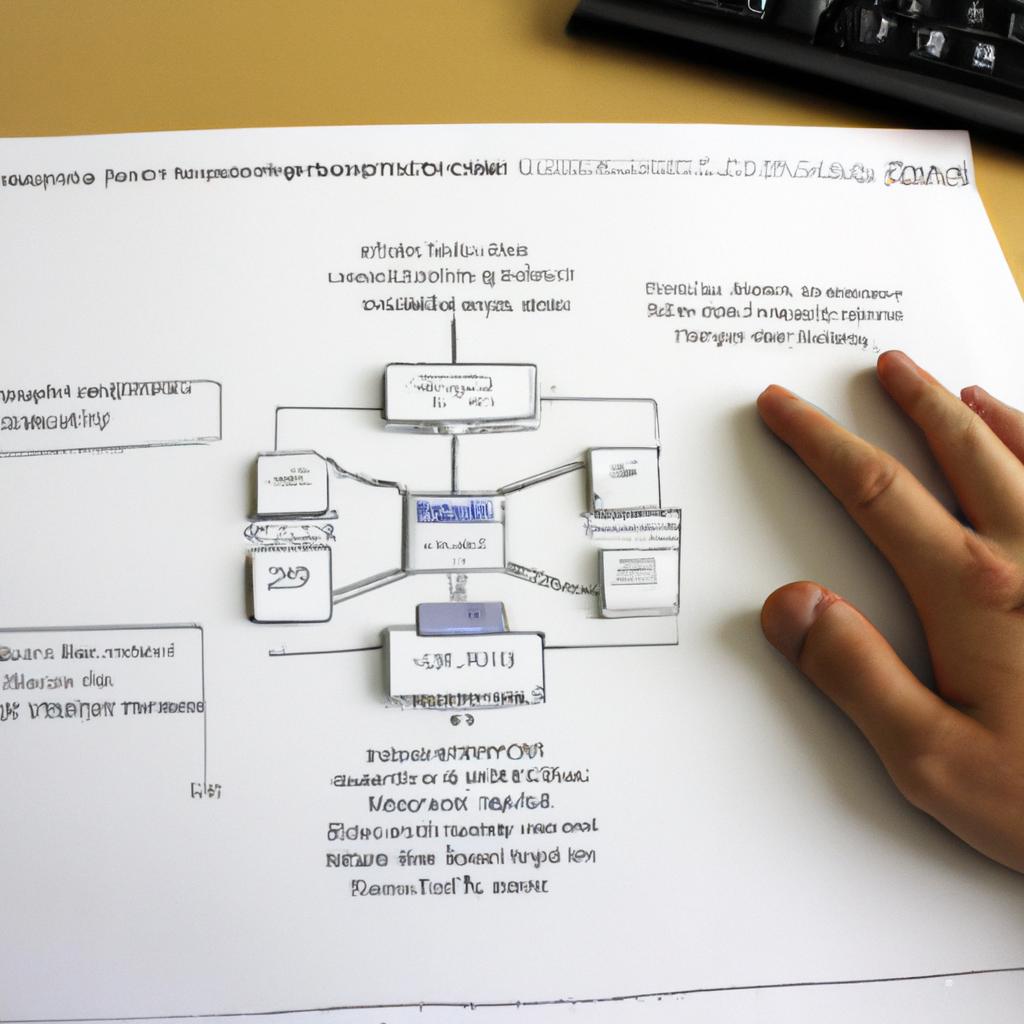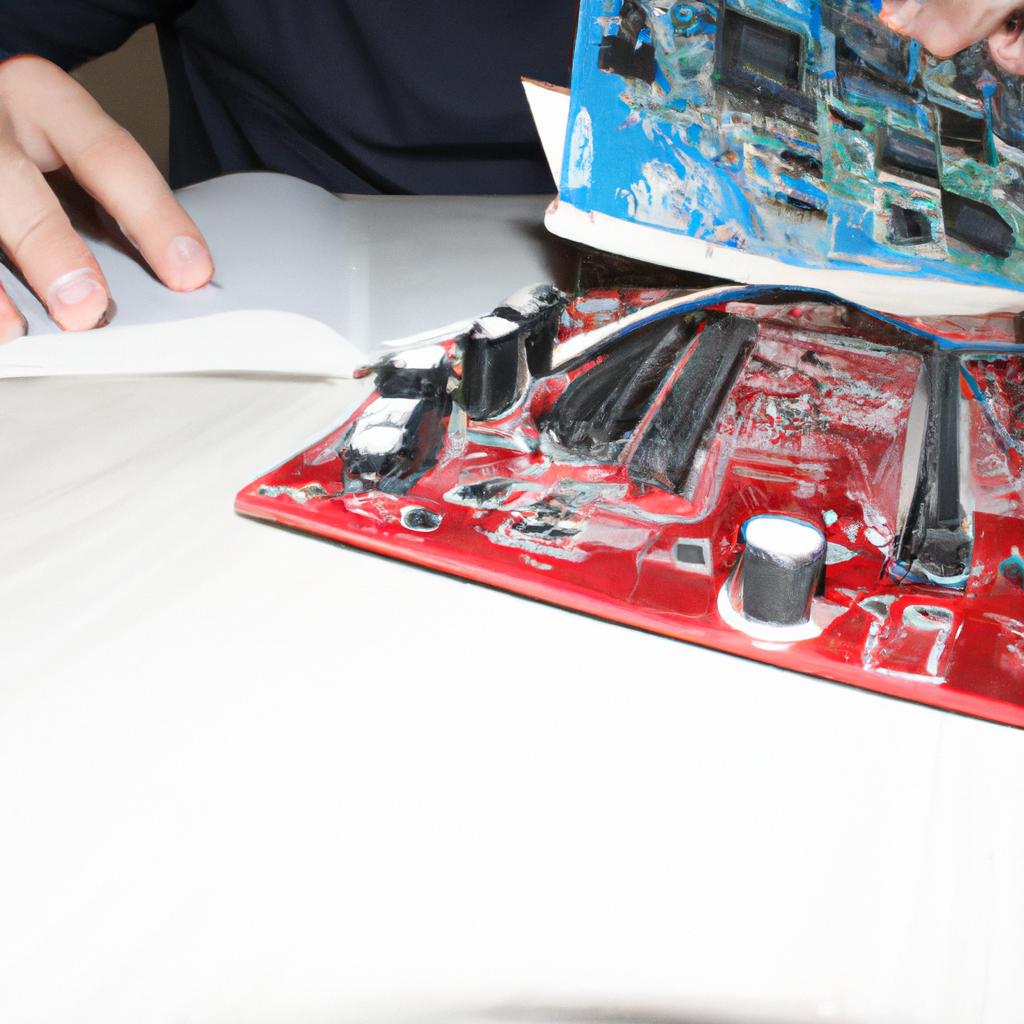Memory hierarchy plays a crucial role in computer architecture, serving as a vital component for efficient data processing and storage. An understanding of memory hierarchy is essential to optimize system performance, particularly when dealing with large-scale applications that require rapid access to vast amounts of data. Consider the case of a high-performance gaming computer, where speed and responsiveness are paramount: without an effective memory hierarchy, the system may struggle to retrieve and process graphics-intensive game assets quickly enough to maintain seamless gameplay.
At its core, memory hierarchy refers to the arrangement of different types of memories in a computing system based on their characteristics such as capacity, cost, and access time. It encompasses various levels of caches (L1, L2, etc.), main memory (RAM), secondary storage devices (hard disk drives or solid-state drives), and even remote storage systems accessed over networks. By organizing these different layers effectively, a hierarchical structure ensures that frequently used data can be stored closer to the processor while less frequently utilized information resides in slower but larger-capacity memories. This approach minimizes latency issues by reducing the time taken for data retrieval operations compared to accessing all information from a single, homogenous type of memory. In essence, memory hierarchy strikes a balance between speed and capacity requirements within limited budget constraints within limited budget constraints and physical limitations.
The primary goal of memory hierarchy is to improve overall system performance by reducing the time it takes for the processor to access data. The faster and more frequently accessed data is stored in smaller, faster, and more expensive caches that are closer to the processor. This allows the processor to quickly retrieve instructions and data without having to wait for them from slower memory types such as RAM or secondary storage.
On the other hand, larger but slower memories like RAM provide a greater capacity at a more affordable cost per unit of storage. They act as an intermediary between the processor and secondary storage devices like hard disk drives or solid-state drives, which have even higher capacities but longer access times.
By arranging these different levels of memory in a hierarchy, data can be efficiently managed based on its temporal and spatial locality. Temporal locality refers to the idea that recently accessed data is likely to be accessed again in the near future, while spatial locality suggests that nearby data addresses tend to be accessed together.
Overall, an effective memory hierarchy enables high-performance systems to optimize their use of resources by storing frequently used data closer to the processor while leveraging larger-capacity memories for less frequently accessed information. This helps ensure rapid access to critical assets and improves system responsiveness, making it essential for various computing applications ranging from gaming computers to large-scale enterprise systems.
Cache memory
Cache memory is a crucial component of the memory hierarchy in computer architecture. It plays a significant role in improving overall system performance by reducing the average time it takes to access data from main memory. To better understand its importance, let’s consider an example scenario.
Imagine you are working on a large and complex project that requires frequent access to various files stored on your computer’s hard drive. Each time you open a file, the operating system retrieves the necessary data from the hard drive and transfers it to main memory for processing. However, this process can be time-consuming since accessing data from the hard drive is relatively slower compared to retrieving it from cache memory.
To highlight the benefits of cache memory, let us explore some key attributes that make it such a valuable component:
-
Speed: Cache memory operates at much higher speeds than main memory or secondary storage devices like hard drives. This speed advantage allows frequently accessed data to be available quickly, thereby significantly reducing access times.
-
Size: Cache memory is typically smaller in size compared to main memory. Its limited capacity ensures only frequently used instructions and data are stored within it, increasing efficiency by prioritizing essential information over less-referenced ones.
-
Locality: Programs often exhibit temporal locality (reusing recently accessed items) and spatial locality (accessing items near previously accessed ones). Cache exploits these properties by storing not only individual items but also blocks of adjacent items, enhancing overall retrieval efficiency.
-
Hierarchy: The concept of cache memory exists within a broader framework known as the memory hierarchy. In this hierarchy, different levels of caching exist with varying sizes and speeds. As we move up the hierarchy towards lower-level caches or main memory, their capacities increase while their latency decreases.
| Attribute | Cache Memory |
|---|---|
| Speed | Faster than main memory |
| Size | Smaller capacity |
| Locality | Exploits temporal and spatial locality |
| Hierarchy | Part of a broader memory hierarchy |
In conclusion, cache memory plays a crucial role in computer architecture by providing faster access to frequently used data. Its smaller size, coupled with its ability to exploit locality and fit within the overall memory hierarchy, contributes to improving system performance.
Main memory
Transition from the previous section:
Having discussed the intricacies of cache memory, we now turn our attention to another crucial component in the memory hierarchy: main memory. In this section, we will explore the characteristics and functionalities of main memory and its role in computer architecture.
Main Memory: The Central Hub
Imagine a scenario where a user is working on a complex computational task that requires accessing large amounts of data. As the processor executes instructions, it continuously retrieves necessary information from main memory. This central hub acts as an intermediary between cache memory and secondary storage, providing fast access to frequently used data sets.
To gain a deeper understanding of main memory, let us examine its key features:
- Capacity: Unlike cache memory, which has limited capacity due to cost constraints, main memory can store significantly larger volumes of data.
- Access Time: While slower than cache memory, main memory still offers relatively quick access times compared to secondary storage devices like hard drives or solid-state drives (SSDs).
- Volatile Nature: Main memory is volatile by design, meaning it loses all stored content when power is disconnected. To ensure data integrity during unexpected outages or system shutdowns, backup mechanisms are employed.
- Addressability: Data in main memory is organized into individual addresses that allow for direct retrieval based on their location.
Let us further illustrate these characteristics through the following table:
| Characteristic | Description |
|---|---|
| Capacity | Large |
| Access Time | Moderate |
| Volatility | Volatile |
| Addressability | Direct |
This overview demonstrates how main memory serves as a critical bridge connecting high-speed cache memories with more capacious but slower secondary storage systems. By striking an optimal balance between capacity and speed, designers aim to maximize overall system performance while minimizing costs.
Looking ahead to our next section on secondary storage systems, we delve into long-term data storage solutions that complement main memory’s performance-oriented nature. Through this exploration, we will gain a comprehensive understanding of the full memory hierarchy in computer architecture.
[Next section: Secondary Storage]
Secondary storage
Memory Hierarchy in Computer Architecture
Continuing our exploration of computer architecture, we now turn our attention to the concept of memory hierarchy. By understanding how different levels of memory interact with one another, we can optimize data storage and retrieval processes. In this section, we will delve into secondary storage, which plays a crucial role in complementing main memory.
Secondary Storage:
To illustrate the importance of secondary storage, let us consider an example. Imagine a large online retailer that needs to store vast amounts of customer transaction data securely. While main memory provides fast access to frequently accessed data, it is limited in capacity and volatile in nature. Therefore, relying solely on main memory for such a significant volume of information would be impractical and inefficient. This is where secondary storage comes into play – providing non-volatile, persistent storage solutions that allow for long-term data retention.
Key Characteristics of Secondary Storage:
- High capacity: Unlike main memory’s limited size, secondary storage devices offer substantial capacities capable of accommodating immense volumes of data.
- Non-volatility: Data stored in secondary storage remains intact even when power is lost or temporarily unavailable.
- Slower access speed: Compared to main memory’s rapid access times, accessing data from secondary storage involves longer latency due to mechanical operations like moving read/write heads or spinning disks.
- Cost-effectiveness: Secondary storage options tend to be more cost-effective per unit of stored information compared to high-speed but expensive alternatives like solid-state drives (SSDs).
Table showcasing various types of Secondary Storage Devices:
| Type | Advantages | Disadvantages |
|---|---|---|
| Hard Disk Drive (HDD) | Large capacity; affordable | Relatively slower than SSDs |
| Solid-State Drive (SSD) | Fast access time | More expensive than HDDs |
| Magnetic Tape | High storage capacity; low cost | Slow access speed |
| Optical Disc | Portable and durable | Limited rewritability |
As we can see, secondary storage provides a vital foundation for efficient data management in computer systems. By offering high-capacity, non-volatile storage options at a more affordable price point compared to main memory, it allows for the long-term retention of data that may not be accessed frequently but still needs to be preserved. In the subsequent section on registers, we will explore another level of memory hierarchy that plays an equally crucial role in computer architecture.
Registers
Having discussed the significance of secondary storage in the previous section, we now turn our attention to another crucial component of computer architecture known as registers. Registers play a vital role in facilitating efficient data manipulation and processing within a computer system.
Registers are high-speed memory units located within the processor that store small amounts of data that are currently being actively used by the CPU. These temporary storage locations hold instructions, operands, and intermediate results during program execution. To illustrate their importance, consider an example where a complex mathematical calculation is performed repeatedly within a loop. By storing the current values of variables involved in the computation inside registers, the CPU can access them quickly without having to fetch them from slower main memory each time, thereby significantly improving performance.
Among the key characteristics of registers are:
- Speed: Registers provide extremely fast access times since they are physically located on the processor itself.
- Size: The size of registers is typically much smaller compared to other forms of memory such as cache or main memory. Their limited capacity restricts them to holding only essential data required for immediate computation.
- Number: A CPU may contain multiple types and sizes of registers, each serving different purposes such as general-purpose registers (GPRs), floating-point registers (FPRs), vector registers (VRs), etc.
- Hierarchy: Registers form part of a hierarchical structure with various levels of memory, each offering different speeds and capacities.
| Register Type | Purpose | Examples |
|---|---|---|
| General-Purpose | Store operands | R0-R31 |
| Floating-Point | Perform arithmetic operations involving decimal numbers | F0-F31 |
| Vector | Accelerate parallel processing tasks | VR0-VR63 |
As we have seen, registers serve as critical components in computer systems by providing fast access to frequently accessed data during program execution. They play a significant role in improving overall system performance by minimizing the need for data retrieval from slower forms of memory, such as main memory or secondary storage. In the subsequent section, we will explore another important aspect of computer architecture known as virtual memory.
Moving forward into the next section, we delve into the concept of virtual memory and its impact on modern computing systems.
Virtual memory
Having discussed the role of registers in computer architecture, we now turn our attention to exploring another crucial element of memory hierarchy – virtual memory.
Virtual Memory:
To illustrate the significance and effectiveness of virtual memory, consider a scenario where a user is running multiple applications simultaneously on their computer. Each application requires a certain amount of memory space to execute its tasks efficiently. However, if the physical memory (RAM) is limited, it becomes challenging for all these applications to reside fully in RAM at once. This is where virtual memory comes into play.
- Virtual memory extends the available addressable space beyond what is physically present by utilizing disk storage as an extension.
- It allows the operating system to create an illusion that each process has access to a large contiguous block of main memory.
- The operating system manages this illusion by dividing processes into fixed-size pages and mapping them onto disk blocks or frames in physical memory.
The advantages offered by virtual memory are numerous and include:
- Enhanced multitasking capabilities
- Efficient utilization of limited physical memory
- Improved overall system performance
- Simplified programming model
Emotional Table:
| Advantage | Description | Example |
|---|---|---|
| Enhanced Multitasking Capabilities | Allows concurrent execution of multiple programs without excessive resource contention | Running video editing software while performing complex calculations |
| Efficient Utilization of Limited Physical Memory | Offers efficient use of available resources when there is insufficient physical RAM | Allowing larger datasets to be processed with limited RAM capacity |
| Improved Overall System Performance | Reduces I/O bottlenecks and improves responsiveness | Facilitating faster loading times for frequently accessed data |
| Simplified Programming Model | Provides developers with an abstraction layer, removing the need for manual management of addresses | Writing code without worrying about physical memory constraints |
In the context of computer architecture, virtual memory is a key component of the memory hierarchy. It allows for efficient utilization of limited physical memory by extending the available addressable space beyond what is physically present. Through its use of disk storage as an extension, virtual memory provides enhanced multitasking capabilities and improved overall system performance. Furthermore, it simplifies the programming model by abstracting away the complexities associated with manual management of addresses.
With a solid understanding of virtual memory in place, we now proceed to explore another integral aspect of memory hierarchy – disk storage.
Disk storage
Considering the importance of virtual memory, it is essential to explore its relationship with disk storage within the broader context of memory hierarchy. By understanding how data moves through different levels of memory, we can optimize system performance and enhance overall computing efficiency.
Section:
The Role of Disk Storage in Memory Hierarchy
To grasp the significance of disk storage in memory hierarchy, let us consider a hypothetical scenario involving a large database management system (DBMS) used by a multinational corporation. This DBMS handles immense volumes of data, ranging from customer records to financial transactions. When queries are executed on this vast dataset, some information may reside outside primary memory due to limitations imposed by physical constraints. As a result, virtual memory serves as an intermediary between main memory and disk storage.
Within the larger framework of computer architecture, several key aspects highlight the role played by disk storage within the memory hierarchy:
-
Capacity: Unlike volatile random access memory (RAM), which offers limited capacity for storing data temporarily, disk storage provides much greater capacity at lower costs per unit. This enables efficient long-term data retention for applications that do not require faster retrieval times.
-
Persistence: Data stored on disks remains intact even when power is lost or turned off—a characteristic known as persistence. This feature ensures durability and allows for reliable backup and recovery processes vital for critical systems like databases.
-
Latency: While accessing data directly from RAM incurs low latency due to its proximity to the processor, retrieving data from disk storage introduces higher latencies due to mechanical movements involved in reading or writing operations. Consequently, optimizing disk access patterns becomes crucial for minimizing delays caused by rotational latency and seek time.
-
Secondary Storage Management: Effective utilization of secondary storage resources involves techniques such as caching frequently accessed data blocks in RAM or employing sophisticated disk scheduling algorithms to minimize access times. These strategies help strike a balance between the need for fast data retrieval and cost considerations.
- Disk storage offers greater capacity at lower costs compared to volatile RAM.
- Data stored on disks is persistent, ensuring durability and enabling reliable backup and recovery processes.
- Retrieving data from disk storage incurs higher latencies due to mechanical movements involved in reading or writing operations.
- Techniques like caching and disk scheduling play a vital role in optimizing secondary storage resources.
Markdown table:
| Aspects | Disk Storage |
|---|---|
| Capacity | High |
| Persistence | Yes |
| Latency | Higher |
| Management | Caching |
In summary, understanding the role of disk storage within the memory hierarchy provides insights into its significance as an intermediary between virtual memory and primary memory. Its larger capacity, persistence, latency characteristics, and management techniques make it an essential component in computer systems with vast datasets. By considering these aspects, we can design efficient architectures that leverage different levels of memory effectively, ultimately enhancing system performance while balancing cost considerations.





